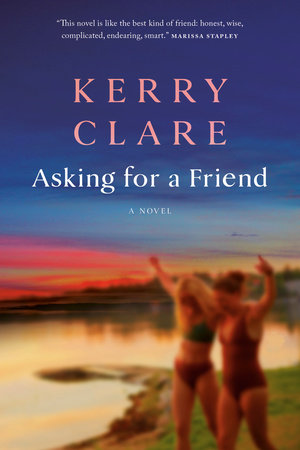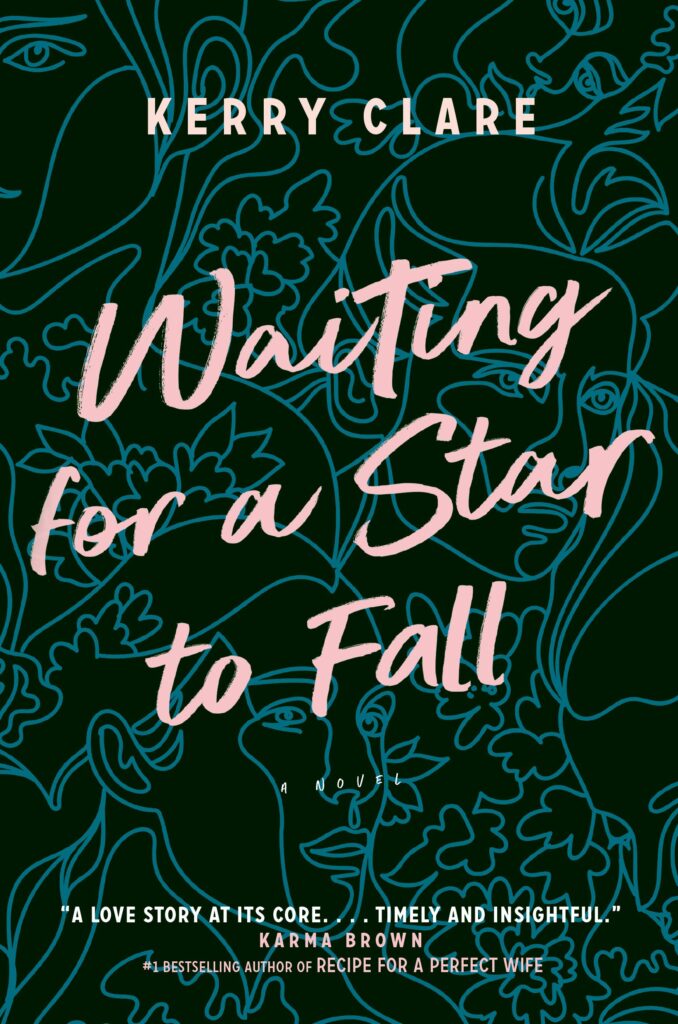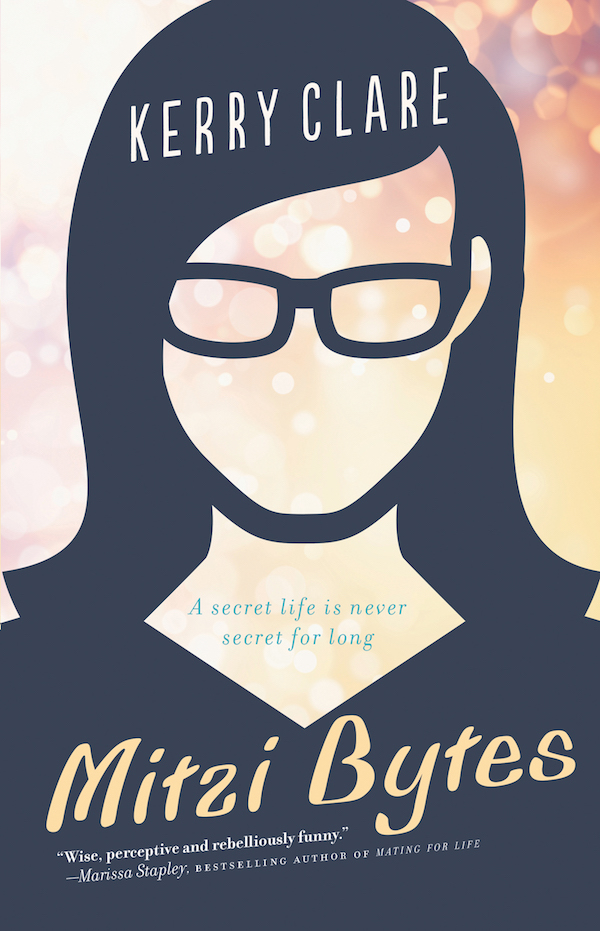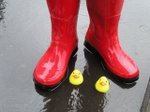June 19, 2009
Ingesting words with his eyes
“Anthony could talk and read at the same time. But his eyes trumped his ears. He usually remembered what he’d read while talking, but he never remembered conversations he’d had while reading. He was like a sleepwalker who grocery-shopped and paid bills in his sleep and forgot it all the next morning. Most of our conversations were now conducted with a book between us– his book, of course. When I read, I shushed him ferociously, for all the good it did me; he had never accepted the fact that other people didn’t possess his unique facility for ingesting words with his eyes while spewing them from his mouth.” –from Trouble by Kate Christensen
June 19, 2009
Flowers in the window
 It was four years ago today that I married my husband and started out on this rather mad journey that has been us as a family. And now we are three! And however terrifying and awful the past month has been very very often, the moments of absolute delight have been sparkling and they’re really all that I’ll remember of it anyway. Stuart’s love and support has been unwavering, his patience infinite, and I couldn’t imagine what this all would have been like without him. He’s as good a daddy as he is a husband, which is certainly something. Harriet and I are a lucky pair, and we love him very much.
It was four years ago today that I married my husband and started out on this rather mad journey that has been us as a family. And now we are three! And however terrifying and awful the past month has been very very often, the moments of absolute delight have been sparkling and they’re really all that I’ll remember of it anyway. Stuart’s love and support has been unwavering, his patience infinite, and I couldn’t imagine what this all would have been like without him. He’s as good a daddy as he is a husband, which is certainly something. Harriet and I are a lucky pair, and we love him very much.
From the song we danced to at our wedding, which I heard for the very first time one sunny morning two days after we first met, when I just knew….:
There is no reason to feel bad,
But there are many seasons to feel glad, sad, mad.
It’s just a bunch of feelings that we have to hold,
But I am here to help you with the load.
Wow, look at you now, flowers in the window
It’s such a lovely day and I’m glad that you feel the same.
‘Cause to stand up, out in the crowd.
You are one in a million and I love you so,
lets watch the flowers grow.
June 17, 2009
Seen Reading
Seated at a table on the patio of Sweet Fantasies Ice Cream at the corner of Bloor Street and Brunswick Avenue, brown-haired woman in non-maternity clothes (but only those purchased around 2003 when she was a bit fat, but non-maternity nonetheless), three weeks post-partum with her baby asleep in the carrier on her chest. She is rereading Good in Bed by Jennifer Weiner, which isn’t much of an intellectual pursuit but it’s enjoyable, and she’s eating a cookies and cream ice-cream cone. The sun is shining and has kissed her cheeks, it’s been days upon days since the last time she cried with despair, and we’ve come such a long way since this all started.
June 15, 2009
The Name Game
We got a cat when I was fourteen, and as I was the oldest and precocious, I decided I would name it. I named it Socks first, I think, after the White House cat (naturally). But then seeing as our cat didn’t have socks, I decided to name it Tim Johnson instead, which was the name of the dog in To Kill A Mockingbird, and I liked the idea of pets with surnames. But that was stupid, so I changed the cat’s name to Daisy, and I can’t remember why. Then we found out that Daisy was a Tom, so I decided she would be called Casey (at the bat?). And then when I decided to change the cat’s name next, my family called it off and Casey the cat stayed, though I never called it that. I always called it Cat, because I’d seen Breakfast at Tiffanys, and wanted to go Golightly.
So this was why I was apprehensive about naming my child. Though I’ve always found names fascinating and entrancing, I’m fickle about them. In many ways, cats and children are different creatures (so I’ve found of late), and you can only change a daughter’s name so many times if you must do it at all. How to pick a name that would stick?
The first name I ever loved was “Julie”, after Mackenzie Phillips’ character on One Day at a Time. Julie was also my best friend in grade one, and I adored her and she beautiful, though she was sensitive about her hairy arms. I went through an “Ellen” phase, after the character on Family Ties, I think. I watched far too much television; I would have died to have been named “Jo”. I fell in love with “Bianca”, not from Shakespeare, but from Shelley Long’s character’s sister in the movie Hello Again. I was particularly impressionable, and agreed that “Cordelia” was the most exquisite name imaginable. I loved the name “Zoe” for a while, and after I read Louise Fitzhugh’s The Long Secret, I thought “Zeeney” was similarly cool, though she’d not been the most appetizing of characters. And these name fixations would go on and on, influenced by all kinds of sitcoms, films and pop stars. I kept ever-changing lists of what my future daughters would be called, though it never occurred to me to think much about a son.
Strange that Louise Fitzhugh ultimately did decide my child’s name. Baby was not to be Zeeney after all (which is good) but Harriet, after the book from which The Long Secret was a sequel. And I’d never read Harriet the Spy until last year, actually, after I heard this feature on NPR. But I fell in love with Ms. Welsch, and her name topped my list. I knew immediately that I wanted a little Harriet of my own one day. I couldn’t think of anyone better to be named after– such a feisty, clever, independent, hilarious, and wonderful character. Impossible too, which strikes me now as a somewhat fortunate/unfortunate quality to project upon one’s child. Perhaps I should have thought it through a little bit more, because this baby fits the bill so far. The name itself means “Home Ruler”, which is appropriate, I think. So this is what we’ve got ourselves in for…
But it sticks. It’s belonged to her since the moment we saw her, and I do love that we now know someone with this name– have a Harriet in our family even! It is a ubiquitous name throughout literature, but all too rare in the real world. I think I’ll not stop loving it soon, because it’s Harriet’s name after all.
Though I do wonder whether she’ll thank us for it. If she’ll find Harriet M. Welsch as charming as I did. It is a tremendous power, isn’t it? Naming a person? Even fictionally, the name is such a determinate and the author certainly bestows innumerable qualities by such a fact. Naming a real person requires as much consideration– this is destiny. I find it strange that we were handed so much power. At the hospital they asked us her name, we told them, and it was that simple. I would have expected some kind of seminar, or at the very least a lecture (a stern one) about the seriousness of the decision we were about to make based on a 1960s children’s novel. Is nothing sacred? Apparently not, but we’re three weeks in, and at the very least, I’ve not wanted to change it yet.
June 12, 2009
A Novel Gift
Stuart and I both like the song “Daughter”, but the lyric “everything she owns, I bought her” doesn’t really apply to our situation. It’s more like, “That’s our daughter in the water, everything she owns was a gift from our extraordinarily generous friends and family.” She gets packages in the post near daily, always full of delightful things. We feel so lucky and appreciative of these gifts, and all the thoughts and good wishes we’ve received. Harriet lacks for nothing, no thanks to us really. Our freezer is also similarly stocked.
But one gift does stand out a bit. In addition to adorable summer outfits, Harriet’s Auntie Jennie also gave us a novel. Or, gave me a novel. It was Catherine O’Flynn’s novel What Was Lost, which I’ve wanted to read for ages. And this novel gift really was particularly novel, because nobody ever gives me books. Oh, as I’ve said, people give me lots of things, but I’ve read so many books already and my tastes are quite defined that friends are more inclined to give me other things. So that rarely do I ever receive a book as a surprise, let alone a book I’ve been dying to read anyway. I imagine I’m not the only bookish sort who suffers from this plight. Oh, the tortured problems of the middle class…
June 9, 2009
Out of Time
 I’m now rereading Tom’s Midnight Garden by Philippa Pearce, prompted by the Harriet/Hatty character within (though ours will be a Hattie, we think, when she’s at home). And the book is more pertinent to my current experience than I would ever have imagined, though it could be said that my mind is so mushy and needy that I could be identifying with pretty much anything right about now. But Tom’s isolation speaks to me, and his insomnia, and the secret world he creeps about in at night when everyone else is asleep. The secret world wherein the clock strikes thirteen, and I feel like I’ve been there lately, up with the squalling baby who refuses to eat properly or be satiated. “Only the clock was left, but the clock was always there, time in, time out.”
I’m now rereading Tom’s Midnight Garden by Philippa Pearce, prompted by the Harriet/Hatty character within (though ours will be a Hattie, we think, when she’s at home). And the book is more pertinent to my current experience than I would ever have imagined, though it could be said that my mind is so mushy and needy that I could be identifying with pretty much anything right about now. But Tom’s isolation speaks to me, and his insomnia, and the secret world he creeps about in at night when everyone else is asleep. The secret world wherein the clock strikes thirteen, and I feel like I’ve been there lately, up with the squalling baby who refuses to eat properly or be satiated. “Only the clock was left, but the clock was always there, time in, time out.”
I loved this book as a child, absorbed as I was by all stories of time travel. From Back to the Future to Charlotte Sometimes by Penelope Farmer, and A Handful of Time by Kit Pearson, and many more I’ve surely forgotten. It’s odd because I’ve never liked science-fiction or fantasy in my fiction, but this one element of genre fiction, I’ve always found so irresistible. Perhaps because the alternate world it plays with is still the very one we live in, which is really the only one that ever interests me, however out of time.
June 6, 2009
Clearest, starkest brilliance
 “Motherhood is a storm, a seizure: It is like weather. Nights of high wind followed by calm mornings of dense fog or brilliant sunshine that gives way to tropical rain, or blinding snow. Jane Louise and Edie found themselves swept away, cast ashore, washed overboard. It was hard to keep anything straight. The days seemed to congeal like rubber cement, although moments stood out in clearest, starkest brilliance. You might string those together on the charm bracelet of your memory if you could keep your eyes open long enough to remember anything.” –Laurie Colwin, from A Big Storm Knocked It Over
“Motherhood is a storm, a seizure: It is like weather. Nights of high wind followed by calm mornings of dense fog or brilliant sunshine that gives way to tropical rain, or blinding snow. Jane Louise and Edie found themselves swept away, cast ashore, washed overboard. It was hard to keep anything straight. The days seemed to congeal like rubber cement, although moments stood out in clearest, starkest brilliance. You might string those together on the charm bracelet of your memory if you could keep your eyes open long enough to remember anything.” –Laurie Colwin, from A Big Storm Knocked It Over
That I’ve read an entire book over the past twelve days means that all is not lost. And indeed, there have been numerous “moments standing out in clearest, starkest brilliance,” though these don’t include the hours we spent in the Sick Kids Emergency when Harriet when just four days old (she was fine, thank goodness, but that experience was like staring straight into hell), her much too-much weight loss that has had both of us struggling to make up for it ever since, that I may have cried as much as she has, and the overwhelming dread at the thought of her Daddy returning to work on Monday. But we’ve enjoyed taking her out for her first walks in her carrier, trying to figure out what she likes (not much, but we suspect being in her carrier is a comfort), getting massages from Daddy, midwife visits where she’s gained an ounce every day, the sun shining through the windows, all the support we’ve had from family, friends and our most excellent neighbours, and that she’s received so good wishes from all over the world. Harriet has also received post every day, though she’s not yet old enough to realize how exciting that is. We’ve also been fortunate that I’ve come through my surgery so well and easily. My crush on the surgeon went into high gear in the days after her birth (which, in spite of the operating room, was as gorgeous as any birth could be, and I don’t feel I’ve missed anything) because he looked like Paul Simon circa 1970s, and because of what a good job he’d done, and what a beautiful baby he’d delivered (though about three nights ago at three o’clock in the morn, I was sorely tempted to go firebomb his house). It’s been a very difficult time for all of us this past while– I’ve never been much inclined to work hard at things I’m not loving, and this isn’t a job I can pass along to anybody else. Though I’m finding, ever-increasingly, those moments standing out in clearest, starkest brilliance when I don’t want to.
May 31, 2009
A fondness for Baskerville
“And Jane, I’d like a beautiful typeface. Devinne or maybe Bembo.”
“We can’t get them,’ said Jane Louise. “I can get you Garamond or Caslon.” She doodled on her pad. Erna was a fountain of little-used or almost extinct typefaces. Jane Louise believed that Erna spent her nights browsing through old type spec books, and Jane Louise was not entirely wrong.
“Oh, these beautiful olds fonts,” Erna said. “What a tragedy.”
“It’s nothing compared to teen pregnancy and wife beating,” Sven said. “I’m sure Janey can get you Bembo for display type.”
A few minutes later Erna withdrew to the editorial floor, leaving Jane Louise with an enormous, untidy manuscript.
“I wonder if old Alfred slaps her around,” Sven said. “Jesus, it’s like having a whole stable of nervous horses in there. I wish she’d shut up about type. It just goes to show that girls are ruined by reading. Even her nasty children have opinions on these subjects. She told me that her oldest had a fondness for Baskerville.”
“All fourteen year olds do,” said Jane Louise.
–from A Big Storm Knocked It Over by Laurie Colwin
May 31, 2009
What life has been like lately…
 I’d post a picture of me and the baby, but as I’ve ceased to wear clothes, I’ve got none that are presentable. Harriet doesn’t wear clothes either, but she pulls it off much better. We’re now inhabiting a Harriet-centric universe, and we like it here. She’s fitting into the family very well, and we’re working hard to get her fatter. Her daddy is so wonderful to both of us, it makes me cry. She looks so much like him that it’s a bit startling, and she’s so beautiful that we can’t stop talking about it. We also can’t stop singing her “Ignition Remix” by R. Kelly, which may have a detrimental effect in years to come. But regardless, I continue to be a very lucky lady.
I’d post a picture of me and the baby, but as I’ve ceased to wear clothes, I’ve got none that are presentable. Harriet doesn’t wear clothes either, but she pulls it off much better. We’re now inhabiting a Harriet-centric universe, and we like it here. She’s fitting into the family very well, and we’re working hard to get her fatter. Her daddy is so wonderful to both of us, it makes me cry. She looks so much like him that it’s a bit startling, and she’s so beautiful that we can’t stop talking about it. We also can’t stop singing her “Ignition Remix” by R. Kelly, which may have a detrimental effect in years to come. But regardless, I continue to be a very lucky lady.
Psst: Harriet is after the spy, of course. I’ll be writing more about that later.
May 28, 2009
Baby Harriet
Harriet Joy was born Tuesday May 26th at 8.30 am. She is perfect and her rather smitten parents are learning all the time. We love her and get to take her home tomorrow, we hope. Thanks for all the good wishes.





